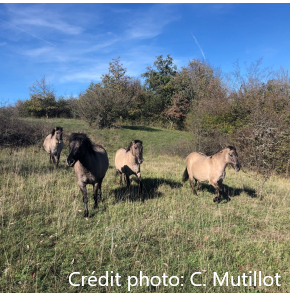
- This event has passed.
4 December 2024 @ 14h00 - 16h00

Mrs Clémentine Mutillod, a doctoral student in the UMR IMBE, EECAR team, will publicly defend her thesis work. Wednesday 4 December 2024at 2pm in the Amphitheatre of the Avignon IUT.
In front of a jury made up of :
- Nathalie Pettorelli, Professor, Institute of Zoology London. Rapporteur.
- Mr Bertrand Schatz, CNRS Research Director, CEFE Montpellier. Rapporteur.
- Marie-Lise Benot, Senior Lecturer, INRAE Bordeaux. Examiner.
- Mr Frédéric Joly, Research Fellow, INRAE Saint-Genès-Champanelle. Examiner.
- Thierry Dutoit, CNRS Research Director, UMR IMBE, IUT Avignon. Thesis supervisor.
- Ms Élise Buisson, Senior Lecturer HDR, UMR IMBE, IUT Avignon. Thesis co-director.
- Mr Laurent Tatin, Doctor, independent researcher, associated with IMBE. Thesis co-supervisor.
Summary of work:
The urgent need to restore ecosystems in the face of declining biodiversity and associated ecological functions has brought rewilding to the forefront of scientific and media attention. Two observations have emerged from recent research: (i) the confusion that exists between ecological restoration and rewilding and (ii) a growing interest in trophic rewilding via the reintroduction (or even the introduction in the case of substitute taxa) of keystone species or ecosystem engineers, such as large herbivores. The latter are of particular interest because of their direct and indirect effects on ecosystems through the consumption of plants, their excrement and trampling. In addition, their wild populations have suffered major extinctions as a result of climate change and hunting by humans, producing cascading effects and loss of ecosystem functions. However, there are still few studies evaluating the effects of their return to ecosystems, on their biodiversity and functions, and even fewer comparing more traditional conservation and restoration actions with the use of domestic animals (and managed as such).
The first chapter of this thesis aims to clarify the objectives and approaches of ecological restoration and rewilding. A review of the scientific literature has been carried out, tracing their origins, comparing their definitions and their most recent principles, and studying the similarities and differences in the approaches and methods used to restore degraded ecosystems. This summary highlights the spatial and temporal complementarity of these two approaches, and underlines the importance for scientists and managers of taking into account the results and feedback from these two strategies.
The research carried out in the other three chapters aims to provide some answers as to the effects of the introduction of large herbivores managed 'as wild' on a herbaceous socio-ecosystem. About thirty years ago on the Causse Méjean (France), Przewalski's horses (Equus ferus przewalskii) were introduced in semi-liberty for the conservation of the species, which was extinct in the wild at the time. This introduction has now made it possible to compare this management system with extensive sheep farming systems (Ovis aries) that have been present in the area for centuries, or domestic horses (Equus ferus caballus) that have been introduced more recently. Three research sub-questions were posed: what are the effects of different herbivores and their associated management (domestic or 'as wild') on herbaceous plant communities (1) via a taxonomic approach and (2) via a functional approach? (3) What are the effects on the assemblages and functional groups of coprophagous beetles, as well as their roles in the degradation of faecal organic matter? Our results show that the introduction of horses (domesticated or managed as 'feral') makes it possible to conserve the pools of species making up the plant communities and assemblages of coprophagous beetles. However, more detailed taxonomic and functional differences are apparent. In particular, the degradation function remains faster in sheep farming systems. These distinctions may be linked to the physiological differences between the animals (sheep vs. horses) and to the type of management (domestic vs. 'like the wild'). In fact, management 'as if in the wild' places a different emphasis on the space made available and the animals' behaviour. These results demonstrate the importance of a multi-compartment approach in order to assess this type of project more globally, and of continuing this research in the future in order to distinguish the effects of the social aspect of herbivores managed 'as wild animals' on the ecosystem. A better understanding of the specific characteristics of the type of herbivore and the type of management will then enable us to refine decisions on the conservation and/or restoration of open and semi-open habitats.
